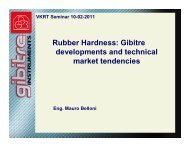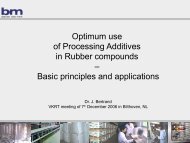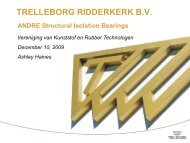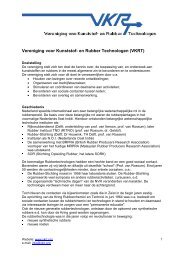PowerPoint - vkrt 2007-12-13
PowerPoint - vkrt 2007-12-13
PowerPoint - vkrt 2007-12-13
You also want an ePaper? Increase the reach of your titles
YUMPU automatically turns print PDFs into web optimized ePapers that Google loves.
Plasticizers for the Rubber Industry –<br />
Legislations, Regulations and the<br />
Consequences<br />
VKRT Meeting<br />
<strong>2007</strong>-<strong>12</strong>-<strong>13</strong><br />
Jürgen Trimbach<br />
Hansen & Rosenthal
Agenda<br />
� Short Introduction of H&R<br />
� Historical overview<br />
� Plasticizers and Legislation<br />
� Actual Activities<br />
� Conclusion<br />
Page 2
Who´s H&R?<br />
H&R WASAG Group<br />
2003 2004 2005 2006<br />
Sales: 211.2m 550m 565m 820m<br />
Chemical/pharmaceutical<br />
raw materials<br />
Sales: 700 m€<br />
Further growth through<br />
acquisition and expansion<br />
of capacity<br />
Leading market positions in<br />
Europe and Asia<br />
Technology leader<br />
Precision plastics<br />
Sales: 55 m€<br />
Further growth through<br />
building up new sites<br />
worldwide<br />
Technology leader<br />
Page 3
Who´s H&R?<br />
The Rubber Industry needed in 2005:<br />
22.000.000 mt rubber (NR, SBR, BR, EPDM, IIR, CR, NBR, …)<br />
16.000.000 mt fillers (Carbon Black, Silica, Clay, Whiting, …)<br />
8.000.000 mt steel and cord<br />
3.000.000 mt plasticizer (DAE, PAR, NAP, MES/TDAE, …)<br />
450.000 mt Sulphur<br />
400.000 mt ZnO<br />
150.000 mt Ozon protecting waxes<br />
1.000.000 mt other chemical specialties<br />
Page 4
Who´s H&R?<br />
The Rubber Industry needed in 2005:<br />
22.000.000 mt rubber (NR, SBR, BR, EPDM, IIR, CR, NBR, …)<br />
16.000.000 mt fillers (Carbon Black, Silica, Clay, Whiting, …)<br />
8.000.000 mt steel and cord<br />
3.000.000 mt plasticizer (DAE, PAR, NAP, MES/TDAE, …)<br />
450.000 mt Sulphur<br />
400.000 mt ZnO<br />
150.000 mt Ozon protecting waxes<br />
1.000.000 mt other chemical specialties<br />
Page 5
Production and<br />
Tank farm for<br />
Process oils<br />
Tank farm for<br />
Process oils<br />
Blend plant<br />
Sales office<br />
Who´s H&R?<br />
New<br />
projects<br />
Page 6
One short Word<br />
Because of Mrs. Elise Goedhart – van der Hout´s<br />
REACH presentation, Mr. Karl Ehlert´s paper<br />
„Legislation on food contact materials in the<br />
Netherlands, European Union and USA “ and other<br />
lectures I will focus my presentation on Aromatic<br />
Plasticizers.<br />
Page 7
� Historical overview<br />
� Plasticizers and Legislation<br />
� Actual Activities<br />
� Conclusion<br />
Page 8
Approx. 4.000 B. C.<br />
Τεν Τεν λαωσ λαωσ ωερε ενουγη ενουγη<br />
ενουγη<br />
Page 9
Approx. 0<br />
Some 200 laws<br />
concerning<br />
production, trading<br />
and taxes<br />
Page 10
1875<br />
We never had so nice<br />
libraries to conceal the<br />
laws.<br />
In Prussia now approx.<br />
1.000 laws and<br />
regulations concerning<br />
production, trading and<br />
taxes, but also the first<br />
safety regulations.<br />
Page 11
Approx. 1920<br />
It has been proved that<br />
polycondensated aromatic<br />
rings can cause cancer,<br />
especially lung and skin<br />
cancer.<br />
PCAs in measurable<br />
amounts, e. g. from<br />
Creasote, are forbidden in<br />
the food and medical<br />
industry.<br />
Page <strong>12</strong>
1960<br />
DAE – Distillated Aromatic<br />
Extract - has to be<br />
substituted in printing ink<br />
applications because of ist<br />
carcenoginic potential<br />
Page <strong>13</strong>
1992 – 2005/2010<br />
EU Substance Directive 1967/548/EC and EU Preparations Directive 1999/45/EC<br />
including adaptations to technical progress:<br />
1992 All distillate aromatic extracts (DAE) are classified<br />
as carcinogens; label “T” and “R45” risk phrase<br />
1994 Other process oils with ≥ 3 % PCA (IP 346) are classified<br />
as carcinogens with labels “T” and “R45” *<br />
1996 All low viscous process oil
<strong>2007</strong><br />
H&R expands its Hamburg<br />
refinery<br />
– plus 80.000 t noncarcinogenic<br />
plasticizers –<br />
and has to follow 86 laws,<br />
regulations and<br />
prescriptions and to fill 1<strong>12</strong><br />
folders with 33.600 pages of<br />
paper for the authorities.<br />
Page 15
� Historical overview<br />
� Plasticizers and Legislation<br />
� Actual Activities<br />
� Conclusion<br />
Page 16
DIRECTIVE 2005/69/EC<br />
… Furthermore, the tyres<br />
and treads for retreading<br />
manufactured after 1<br />
January 2010 may not be<br />
placed on the market if<br />
they contain extender oils<br />
exceeding the limits<br />
indicated in paragraph 1.<br />
…<br />
Page 17
The Requirements<br />
Plasticizers for tyres have to fullfill:<br />
IP 346 < 3,0 %<br />
B(a)P < 1 ppm or<br />
8 Grimmer PCAs < 10 ppm<br />
BP NMR < 0,35<br />
No exceptions allowed – no aviation, racing or special<br />
industry tyre<br />
Plus<br />
Mutagenicity Index < 1<br />
Page 18
DMSO Extraction (IP 346)<br />
+ Cyclohexane<br />
+ H 2 O/NaCl<br />
Sample +<br />
Cyclohexane, DMSO<br />
+ H 2 O<br />
+ Cyclohexane<br />
Page 19
DMSO Extraction (IP 346)<br />
+ Cyclohexane<br />
+ H 2 O/NaCl<br />
Sample +<br />
Cyclohexane, DMSO<br />
+ H 2 O<br />
+ Cyclohexane<br />
Page 20
Individual PCAs (GC-MS)<br />
Pre-treated sample<br />
Page 21
Individual PCAs (GC-MS)<br />
Page 22
Bay Proton NMR (ISO 21461)<br />
Definition of PCA (= PAH, PNA, PKA, …):<br />
Polycyclic aromatic hydrocarbons are organic compounds<br />
consisting of two or more aromatic rings where certain carbon<br />
atoms are common to two, three or more rings.<br />
The name hydrocarbon indicates that the molecule contains<br />
only carbon and hydrogen.<br />
Page 23
Bay Proton NMR (ISO 21461)<br />
� Extraction with Acetone<br />
� Oil to disolve in CDCl3<br />
� NMR spectrum, calculation<br />
I 2<br />
H Bay = I1 + I 3<br />
x 100<br />
I 1 = Pure Aromatic area<br />
I 2 = Bay region defined from 8,3 ppm to 9,50 ppm<br />
I 3 = Aliphatic and ethylenic regions defined from 0,2 ppm to 5,8 ppm<br />
H = percentage of Bay protons<br />
Page 24
Bay Proton NMR (ISO 21461)<br />
Benzo-(a)-pyrene H<br />
5-Methylchrysene<br />
(not in the Grimmrer substancies)<br />
Bay region<br />
H<br />
H<br />
H<br />
CH 3<br />
H<br />
Bay region<br />
Page 25
Bay Proton NMR (ISO 21461)<br />
Methylnaphthaline<br />
CH 3<br />
Page 26
Bay Proton NMR (ISO 21461)<br />
Methylnaphthaline<br />
Bay region<br />
Benzo-(a)-thiopyrene H<br />
Definition of PCA:<br />
H<br />
H<br />
H<br />
C<br />
Bay region<br />
…. The name hydrocarbon indicates that the<br />
molecule contains only carbon and hydrogen.<br />
H<br />
H<br />
S<br />
Page 27
� Historical overview<br />
� Plasticizers and Legislation<br />
� Actual Activities<br />
� Conclusion<br />
Page 28
Legal Defaults - Consequences<br />
DAE for tires has to be substituted by alternative oils asap!<br />
The worldwide consumption is 1.000.000 tons per year!<br />
The consumption in Europe is 300.000 tons, in Asia 400.000 tons/year!<br />
ExxonMobil: DAE has been stopped 2003-<strong>12</strong>-31<br />
(Mobilsol types)<br />
Shell & DEA: DAE has been stopped 2004-06-30<br />
(Dealen types, Extrakt IE)<br />
Total/Fina: Step out in <strong>2007</strong><br />
BP: No more business with process oils<br />
DAE will become short<br />
Page 29
DAE Substitutes<br />
Structure DAE TDAE MES RAE NAP<br />
Aromatic > 35 20 - 25 10 - 15 >25 < 10<br />
Naphthenic 30 30 30 30 40<br />
Paraffinic 30 45 60 40 50<br />
Viscosity @ 40 °C 500 - 1.500 200 – 1.200 200 > 3.000 500 - 2.000<br />
VGC 0,96 0,9 0,86 0,87 0,87<br />
VGC = f(Aromatic content, polarity)<br />
Page 30
DAE Substitutes<br />
Structure DAE TDAE MES RAE NAP<br />
Aromatic > 35 20 - 25 10 - 15 >25 < 10<br />
Naphthenic 30 30 30 30 40<br />
Paraffinic 30 45 60 40 50<br />
Viscosity @ 40 °C 500 - 1.500 200 – 1.200 200 > 3.000 500 - 2.000<br />
VGC 0,96 0,9 0,86 0,87 0,87<br />
TG - 40 °C - 50 °C - 60 °C -45 - -60 °C - 60 °C<br />
Available in<br />
huge quantities<br />
? Availability<br />
unsure<br />
Page 31
Legal Defaults - Consequences<br />
Name<br />
Styrene content<br />
[phr]<br />
Oil type<br />
Oil content Tg<br />
[phr] [°C]<br />
17<strong>12</strong> 23,5 DAE 37,5 -50<br />
1723 23,5 TDAE 32,5 -52<br />
1732 32,0 MES 32,5 -51<br />
1721 40,0 DAE 37,5 -30<br />
1739 40,0 TDAE 37,5 -36<br />
1740 40,0 MES 32,5 -44<br />
Today also a wide range of label free OE S-SBR is available<br />
(for example from Lanxess, DOW, Eni, JSR, Asahi, Nippon Zeon, ..)<br />
Also the first label free OE NR ex Malaysia is available.<br />
Page 32
Production of Plasticizers by Extraction<br />
Paraffins<br />
Aromatics<br />
MES<br />
DMSO-<br />
Extract<br />
Benzo-(a)pyrene<br />
8 Grimmer<br />
substancies<br />
Waxes<br />
Paraffins<br />
Unit DAE TDAE<br />
w-% 25 - 40 < 3<br />
ppm 30 - 50 < 1<br />
Aromatics<br />
ppm 50 - 150 < 10<br />
PCAs<br />
Distillate<br />
Aromatics<br />
TDAE<br />
DAE<br />
Aromatics<br />
PCAs<br />
Page 33
Production of Plasticizers by Hydrogenation<br />
Aliphates<br />
(more<br />
Alkanes)<br />
Aromates<br />
MES<br />
Waxes<br />
Aliphates<br />
Aromates<br />
PCAs<br />
Distillate<br />
Aliphates<br />
(more<br />
Naphthenes)<br />
Aromatics<br />
NAP<br />
Page 34
How to chooce the right Oil?<br />
Viscosity: the viscosity has a drastic impact concerning<br />
the processing behaviours<br />
Density: with constant viscosity the density increases<br />
by increasing aromatic content<br />
Both key properties are linked by the<br />
constant of density and viscosity (VGC)<br />
VGC =<br />
Density - 0,24 x 0,022 log (viscosity - 35,5)<br />
0,755<br />
The higher the VGC the higher the aromatic content<br />
Page 35
BR<br />
NR/IR<br />
SBR<br />
IIR<br />
EPDM<br />
CR<br />
NBR<br />
PVC<br />
paraffinic naphthenic aromatic highly synthetic<br />
aromatic<br />
TDAE for new BrIIR:<br />
Optimal results with TDAE<br />
MES<br />
NAP<br />
TDAE<br />
DAE<br />
confirmed by Exxon Chemicals<br />
(RubberWorld May <strong>2007</strong>)<br />
0,80 0,85 0,90 0,95 1,00<br />
constant of density and viscosity (VGC)<br />
Page 36
� Historical overview<br />
� Plasticizers and Legislation<br />
� Actual Activities<br />
� Conclusion<br />
Page 37
Conclusion<br />
The new legislation is only a problem for the tyre<br />
industry.<br />
That´s not true!<br />
Also the autmotive industry is asking for label free<br />
products or products made with uncritical<br />
rawmaterials (Mercedes, GM/Opel, BMW, Toyota).<br />
That means also the TRG producer have to take care<br />
of label free plasticizers.<br />
Page 38
Conclusion<br />
The production/purchase of DAE will also become<br />
problematic!<br />
• The DAE producers will loose 75 % of the market<br />
(tire producers – 20 companies are 95 % of that<br />
market)<br />
• 25 % of the DAE market means 25.000 companies<br />
• The market becomes uninteresting<br />
• DAE will be used more as crackerfeed than as<br />
palsticizer<br />
• DAE becomes shorter and expensive<br />
REACH<br />
will this new regulation be the final death of DAE?<br />
Page 39
A last Slide<br />
Viscosity @ 100 °C [mm²/s]<br />
90<br />
80<br />
70<br />
60<br />
50<br />
40<br />
30<br />
20<br />
10<br />
0<br />
0 10 20 30 40 50<br />
Aromatic content [wt. %]<br />
MES<br />
TDAE<br />
RAE<br />
DAE<br />
PAR<br />
Page 40
Last not least<br />
Do you have any question?<br />
Page 41
Last not least<br />
I wish all of you a merry Christmas<br />
and a happy new year!<br />
Page 42











